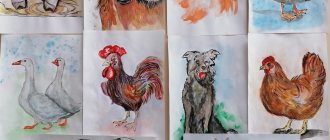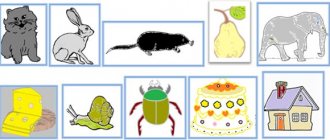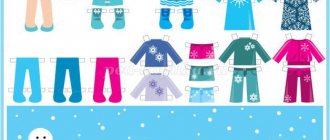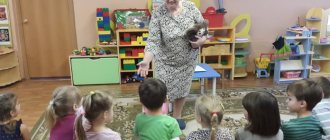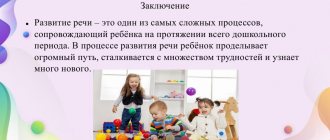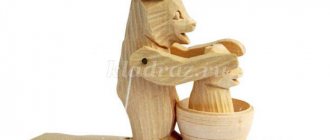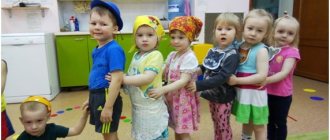Notes “Describe the subject”
Let's check who's right. Let's play "Magic Bag". A small ball is placed in the bag. Children touch the object and determine its shape.
-What do you think it is? (Ball).
- We already have the ball. What colour is he? (Green)
— What color is the ball in the bag? (Cannot be determined)
The ball is taken out of the bag. It is concluded that the shape of an object can be determined by looking at it and touching it with your hands, but the color can only be seen.
4. “What color.” The speech therapist places a “color” symbol card on the board.
- What do you think we will call it? (Color)
Children pass the ball and name the object being demonstrated and its color: the pillow is blue...
5. “Say it kindly.” The children are shown balls.
- What do the balls have the same? (Color)
- What are the differences between the balls? (Size)
- Big ball, what should we call the small one? (Ball).
Children pass the ball and call the objects on display affectionately: sun - sun...
6.Phys. just a minute. Exercises are done by reciting a poem:
“We'll clap our hands, we'll stomp a little.
Let's shake our heads.
We shouldn't be discouraged. Let's raise our hands.
Now let’s sit down together, we really need to rest.
We'll clap our hands and stamp our feet a little."
7. “What it’s made of is what it’s called.” The speech therapist attaches a symbol card “what is it made of” to the board. It turns out that the objects that people made are made of different materials. Iron, wooden and plastic buttons are on display. Children examine and feel the buttons and, in conjunction with a speech therapist, form relative adjectives: a button made of iron is iron, a button made of plastic is plastic, a button made of wood is wooden. When passing the ball to each other, children use relative adjectives, giving characteristics to the objects being demonstrated: an iron top - an iron top.
8. “What does it feel like?” The speech therapist places a “what it feels like” symbol card on the board. What else can you say about an object if you don’t see it, but only touch it? Let's check. Game "Magic Bag". There is a small soft toy in the bag.
- What does the object feel like? (Soft).
-What do you think is in the bag? (Children's answers).
Show the toy. Children pass the ball and name the objects on display, characterizing their structure (hard, soft, prickly)
9. “What does it taste like?” The speech therapist places a “taste” symbol card; lips or tongue are depicted on it.
- What else can you say about edible items? (What do they taste like).
Children, passing the ball, remember foods that have a given taste.
- What's sweet? Sweet apple (sour, bitter, salty)
10. Exercise “Describe me.” Children, with the help of a speech therapist, using picture symbols, make up a descriptive story about a toy kitten, a spruce twig, a ball, an orange.
Open lesson
Municipal budgetary preschool educational institution "Child Development Center - Kindergarten No. 16 "Inspiration" Open lesson on speech development
Didactic game “Whose Thing?” and examination of the plot picture
Educator:
Torgovtseva E. Yu.
Yurga 2022
Target:
Continue to teach children to look at the plot of the picture, helping them understand the plot of the picture and characterize the relationships between the characters. Practice agreeing possessive pronouns with nouns and adjectives.
Tasks:
Educational:
- teach children to compose a descriptive story based on a plot picture with the help of a teacher, actively finishing the words, naming items of clothing and the actions of the characters;
- learn to answer questions about the content of the picture;
- consolidate knowledge about the shape and color of an object.
Developmental:
- develop memory,
perception, imagination
,
speech;
- develop the ability to establish relationships between depicted objects;
— continue to develop the prerequisites for active speech.
Educators:
- cultivate attention in children: listen to the teacher’s story, perseverance;
- cultivate curiosity;
— cultivate a friendly attitude towards animals and loved ones.
Vocabulary work: fluffy, red, good, green, red, bow, girl, boy, cat.
Preliminary work: looking at the picture.
Material:
A box of toys for each child, a letter from a bear, a story picture “Playing with a kitten,” soft toys.
Surprise moment. Children enter the group; on the table there is a box with a letter from the bear. A box of toys for children - a gift from a bear for help.
Educator: “Look kids, the bear gave you and me a box of toys. Let's play with them. But first we will solve the riddle. Just listen carefully.
This is a children's playground. The ball is here, the bucket, the shovel. Both boys and girls brought with them... (Toys)
Well done right!
Children walk onto the carpet onto chairs in a semicircle in front of the teacher. Each child has a toy in his hands. Children are given the opportunity to examine objects. The teacher asks all children to answer the questions: “Masha, what do you have in your hands?” (color, shape, name of the toy).
The teacher asks the children to close their eyes and takes 4-5 objects. Then he asks you to open your eyes and asks: “Whose thing? If it’s a draw, I’ll keep it for myself.” The teacher tells you how to answer the question: “This is my red bucket. This is my yellow owl."
The teacher invites the children to exchange objects. Then he finds out who exchanged what with whom. It tells you how to talk about it more correctly. The children close their eyes again and the game repeats.
Teacher: “Well done guys, let’s put the toys in a box and rest a little”
.
Physical education is being held
:
Here comes the red cat (steps with legs raised high)
Hidden - waiting for the mouse (sit down, press your hands to your knees)
The mouse will go around the hole (stand up, turn around)
And it won’t get to the cat! spread your arms to the sides )
.
The teacher offers the children a plot picture “Playing with a kitten”
.
“Do you think dolls and animals love to be played with and taken care of,” the teacher begins the lesson. I know such a cat. Would you like to see this cheerful Fluffy?”
Gives you the opportunity to look at it and exchange impressions. Then he continues the conversation. “Do you like the cat? Describe it. He (very handsome, red-haired, fluffy, good-eyed)
.
Who did the cat want to play with? A boy in a green blouse (holding a bow on a string)
.
The baby calls him to play. How he does it? He tells him something. What do you think?
Look at the girl in a red sundress. What is she doing? (wants to pet the kitten)
Do you think these kids take care of their pets? Do you take care of your animals at home? Well done. Let’s take a look at our little animals and cuddle our dolls, give them some love.”
Self-analysis of the lesson
Didactic game “Whose Thing?”
and examination of the plot picture
I conducted an open lesson on speech development. Didactically
game "Whose thing?" and examination of the plot picture.
The participants were children of the younger group in the amount of 8 children
During the game, a goal
:
Continue to teach children to look at the plot of the picture, helping them understand the plot of the picture and characterize the relationships between the characters. Practice agreeing possessive pronouns with nouns and adjectives.
And such problems
:
Educational:
- teach children to compose a descriptive story based on a plot picture with the help of a teacher, actively finishing the words, naming items of clothing and the actions of the characters;
- learn to answer questions about the content of the picture;
- consolidate knowledge about the shape and color of an object.
Developmental:
- develop memory,
perception, imagination
,
speech;
- develop the ability to establish relationships between depicted objects;
— continue to develop the prerequisites for active speech.
Educators:
- cultivate attention in children: listen to the teacher’s story, perseverance;
- cultivate curiosity;
— cultivate a friendly attitude towards animals and loved ones.
Educational area:
speech development.
Preliminary work:
looking at the picture.
Material:
a box with toys for each child, a letter from a bear, a story painting “Playing with a kitten,” soft toys.
The educational activity itself consisted of three interconnected parts, during which children gradually performed various actions. This structure is completely justified, since each part of direct educational activity is aimed at solving certain problems and offers a choice of methods and techniques.
Introductory part: organization of children, motivation for upcoming activities.
(a surprise moment - in the group there was a chest that needed to be opened using a riddle that had to be guessed)
The main part of the educational activity was a specially organized and independent activity of children aimed at solving assigned problems.
- Examination of objects (toys).
She talked about toys. She asked guiding questions to consolidate the material covered and develop verbal communication
— For general warm-up, we played the didactic game “Whose Thing?”
— To create a joyful mood, I suggested looking at the plot painting “Playing with a Kitten.”
In the final part, GCD also used the play method (let’s look at our toys and dolls and pet them and play)
To implement each task, I selected techniques that helped solve them. The techniques were based on playful learning situations in which I tried to encourage children to engage in active speech activity.
The material for the educational activities was selected at a level accessible to children, corresponded to age characteristics and was rational for solving the set goals and objectives. The children were active, attentive, and felt comfortable. All this is confirmed by the results of our activities.
All elements of GCD are logically united by a common theme. Activities at GCD are characterized as joint and individual.
Methods and techniques:
• Informative – (examination, observation, example of a teacher, demonstration of a teacher);
• Verbal method (verbal, artistic expression, use of teacher’s samples);
• Reproductive method (repetition technique);
• Heuristic method (showing independence).
We describe the objects around us, our actions and sensations
The Child Development project offers parents, educators and teachers eleven original practical tasks for the harmonious all-round development of the child. Completing tasks will develop imagination and fantasy, expand your vocabulary and horizons, and will help you remember the spelling of words. During classes with such handouts, the child will acquire the ability to classify objects, develop attention and observation, improve the culture of speech, and interest in learning the language.
Completing the proposed tasks will contribute to the formation in children of a positive attitude towards learning, instilling self-confidence and their educational capabilities, which is an important key to the comprehensive development of the child.
Learning to describe sensations. This set of tasks will help your child expand his vocabulary and learn to more accurately describe objects in the world around him and his feelings. In this way, the child will develop figurative and abstract thinking and writing skills.
We describe the properties of objects, creatures and substances. This kit will help your child learn to compare and describe objects and creatures based on specific characteristics, while simultaneously developing drawing, reading, observation and attentiveness skills.
Describe the pictures: use of adjectives. This set of tasks will help your child learn to describe objects and creatures and use adjectives correctly in speech. The set contains 24 drawings, for each of which the child must select 5 adjectives that characterize him.
We describe the sequence of actions: skills of coherent written speech. This set of tasks will help your child learn to describe a sequence of actions and practice written, coherent speech skills. In each of the 8 tasks, the child is asked to describe the stages of performing a certain action.
Drawing, question, sign: we classify objects. The proposed task will familiarize children with the lexical meaning of words that name the characteristics of objects, will develop the ability to ask questions about words, and will enrich their vocabulary. The child is asked to select questions and a sign for each picture and connect them with arrows.
Item materials: distributing words. The proposed task will help the child learn about the names of materials (paper, wood, glass), learn to distinguish and name the properties and qualities of objects, and enrich their vocabulary. By completing tasks, the child will learn to compare, group, classify objects according to materials and properties, and find common and different things.
Describe the pictures and compare. This set of tasks will help your child learn to describe and compare creatures, and express their thoughts and conclusions in writing. The tasks will help you enrich your vocabulary, develop fine motor skills, writing and comparison skills, and learn to express thoughts consistently.
We describe concepts and learn to think. This unusual activity asks your child to think about important concepts that we use every day, but usually don't think about their deeper meaning. According to the terms of the task, the child needs to describe each of the proposed concepts using three adjectives.
Cold or hot? We analyze objects of the surrounding world. The proposed task will help the child learn to distinguish the properties and qualities of objects, determine the common and distinctive features of objects in the surrounding world, compare, combine, and divide into groups. By completing the task, the child will develop logical thinking, intelligence, and curiosity.
We describe imaginary places: develop imagination. This set of activities will help your child develop their imagination and learn to describe different places, drawing on their experience. By completing tasks, the child will develop creative abilities and fine motor skills, and learn to express thoughts consistently. During group work, you can ask children to read their descriptions out loud and compare.
Edible, inedible. We analyze objects of the surrounding world. The proposed task will help the child learn to distinguish the properties and qualities of objects, determine the common and distinctive features of objects in the surrounding world, compare, combine, and divide into groups based on common characteristics.
Each task can be printed on a regular or color printer and used an unlimited number of times. Downloading tasks for children is available to site users after quick registration.

